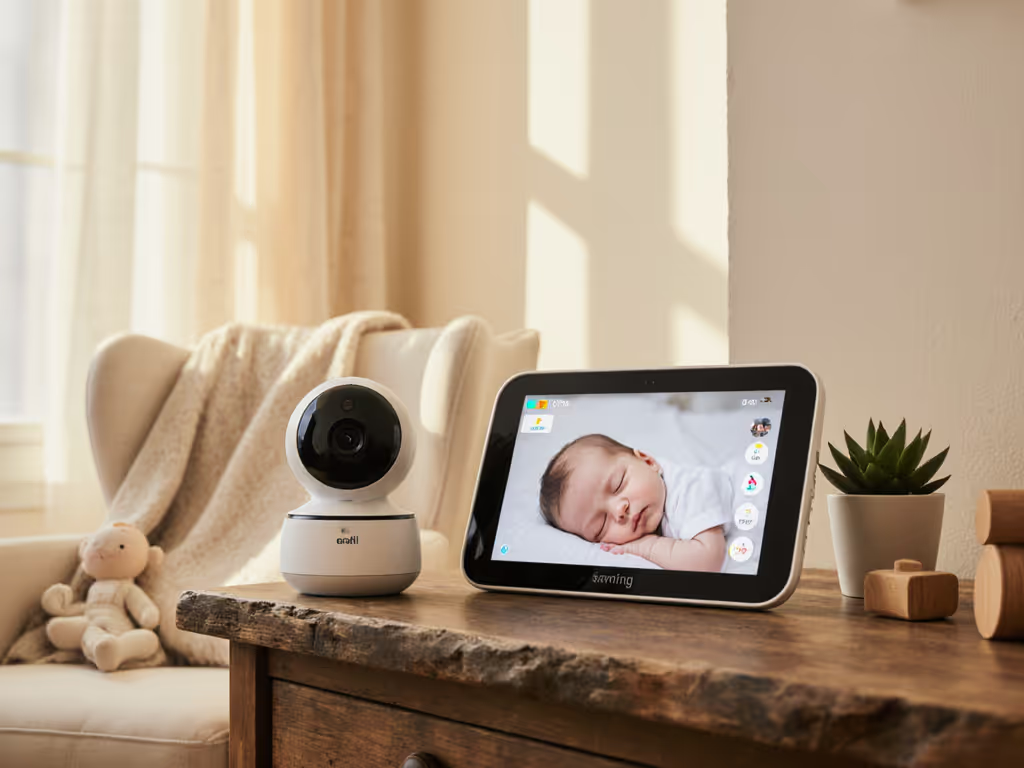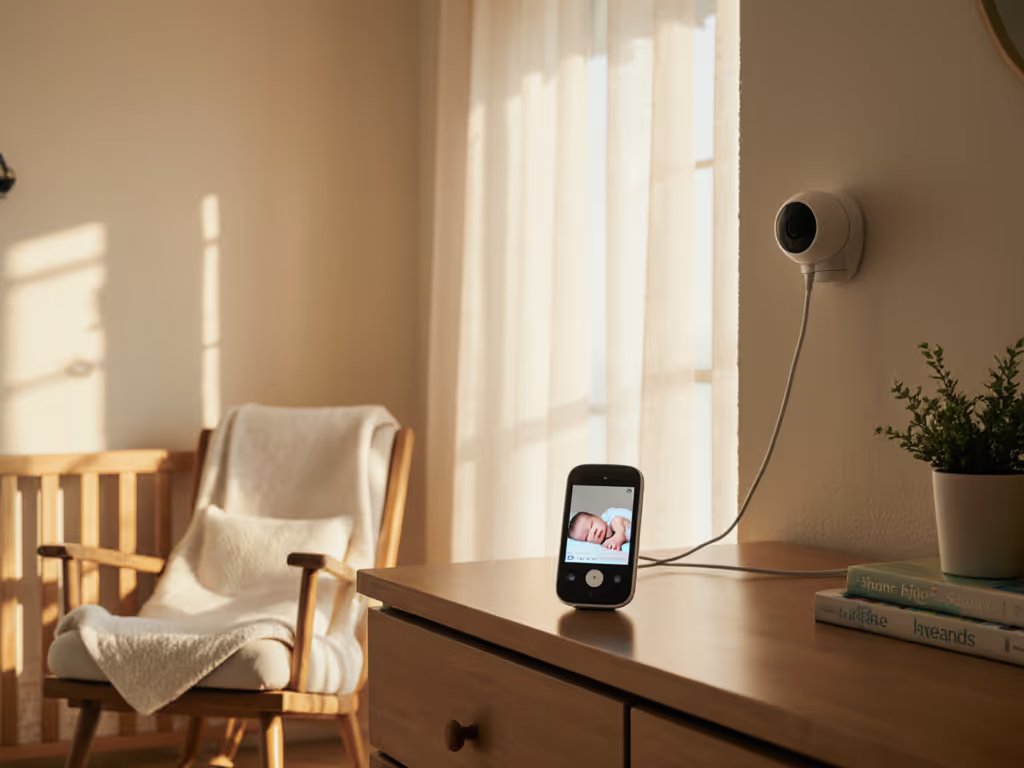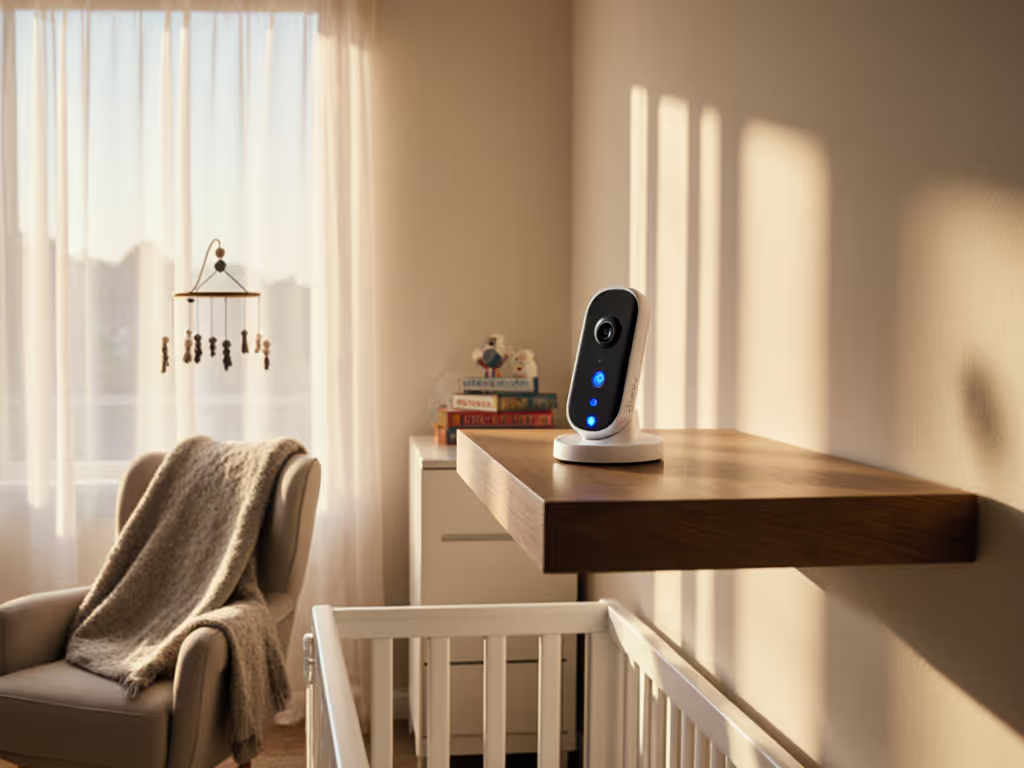
Why Monitor Baby’s Room Environment: Essential Guide
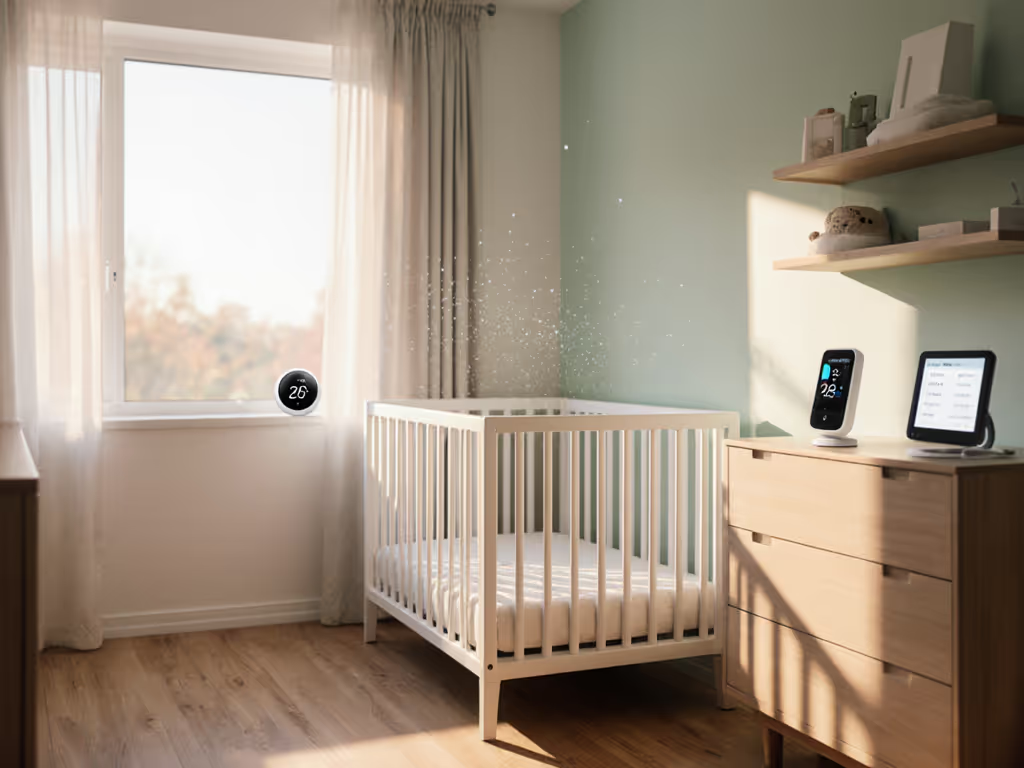
More than 90 percent of parents worry about their baby's comfort and safety while sleeping in the nursery. With so many environmental factors at play, from temperature swings to invisible pollutants, keeping track can feel overwhelming. Monitoring your baby’s room environment gives you a clear picture of what’s really going on, turning anxious guesswork into actionable insights for better health and peace of mind.
Key Takeaways
| Point | Details |
|---|---|
| Comprehensive Environmental Monitoring | Systematic tracking of temperature, humidity, air quality, sound, and light enhances infant comfort and safety. |
| Awareness of Environmental Hazards | Parents must proactively monitor potential risks, including lead, pesticides, and indoor air pollutants. |
| Advancements in Baby Monitoring Technology | Modern baby monitors integrate advanced sensors and IoT technology, providing real-time insights and predictive capabilities. |
| Privacy and Security Measures | Ensuring robust privacy protocols, such as encryption and secure authentication, is crucial for protecting sensitive family data. |
Defining Baby's Room Environment Monitoring
Monitoring your baby's room environment goes beyond simply watching their movements. It involves systematically tracking multiple environmental factors that directly impact infant comfort, health, and safety. Room environment monitoring transforms parental vigilance from guesswork into a data-driven approach that provides real-time insights into the conditions surrounding your child.
At its core, baby room environment monitoring encompasses tracking several critical parameters:
- Temperature stability to ensure optimal thermal comfort
- Humidity levels that prevent respiratory and skin irritations
- Air quality indicators measuring potential pollutants or allergens
- Sound levels detecting potential disruptions or unusual noises
- Light conditions understanding sleep-wake cycle influences
These interconnected measurements create a comprehensive picture of your baby's immediate surroundings. Advanced monitoring systems use sophisticated sensors that can detect minute changes, alerting parents to potential issues before they become significant problems. For instance, slight temperature fluctuations or unexpected noise spikes could indicate underlying environmental challenges that might disrupt your infant's sleep or comfort.
Understanding environmental monitoring is not about creating anxiety but empowering parents with actionable information. By transforming abstract environmental data into clear, understandable insights, these systems help caregivers make informed decisions about nursery setup, sleeping conditions, and overall infant wellness. The goal is proactive care - preventing potential discomfort or health risks through continuous, intelligent observation of your baby's living space.
Types Of Environmental Hazards To Monitor
When it comes to protecting infants, understanding the potential environmental hazards lurking in a baby's room is critical. Research from leading medical publications highlights several key areas of concern that parents must vigilantly monitor to ensure their child's health and safety. These environmental risks range from invisible air pollutants to tangible chemical exposures that can significantly impact a child's developing immune and respiratory systems.
According to research from PubMed and PMC, the most significant environmental hazards in an infant's room include:
- Lead contamination: Potentially present in old paint, dust, or household materials
- Pesticide exposure: Can enter through clothing, shoes, or outdoor contaminants
- Environmental tobacco smoke: Known to cause severe respiratory complications
- Indoor air pollutants: Including volatile organic compounds (VOCs) from furniture, carpets, and paint
- Allergens: Such as dust mites, pet dander, and microscopic particulate matter
Understanding these hazards requires more than passive observation. Proactive monitoring involves implementing comprehensive strategies that minimize exposure and create a protective environment. This means regularly assessing air quality, using appropriate filtration systems, maintaining clean surfaces, and being aware of potential sources of contamination that might not be immediately visible.
Each environmental hazard presents unique challenges. For instance, lead exposure can occur through seemingly innocuous sources like old paint chips or contaminated dust, while indoor air pollutants can emanate from everyday household items. By developing a systematic approach to identifying, measuring, and mitigating these risks, parents can create a safer, healthier living space that supports their infant's critical developmental stages.
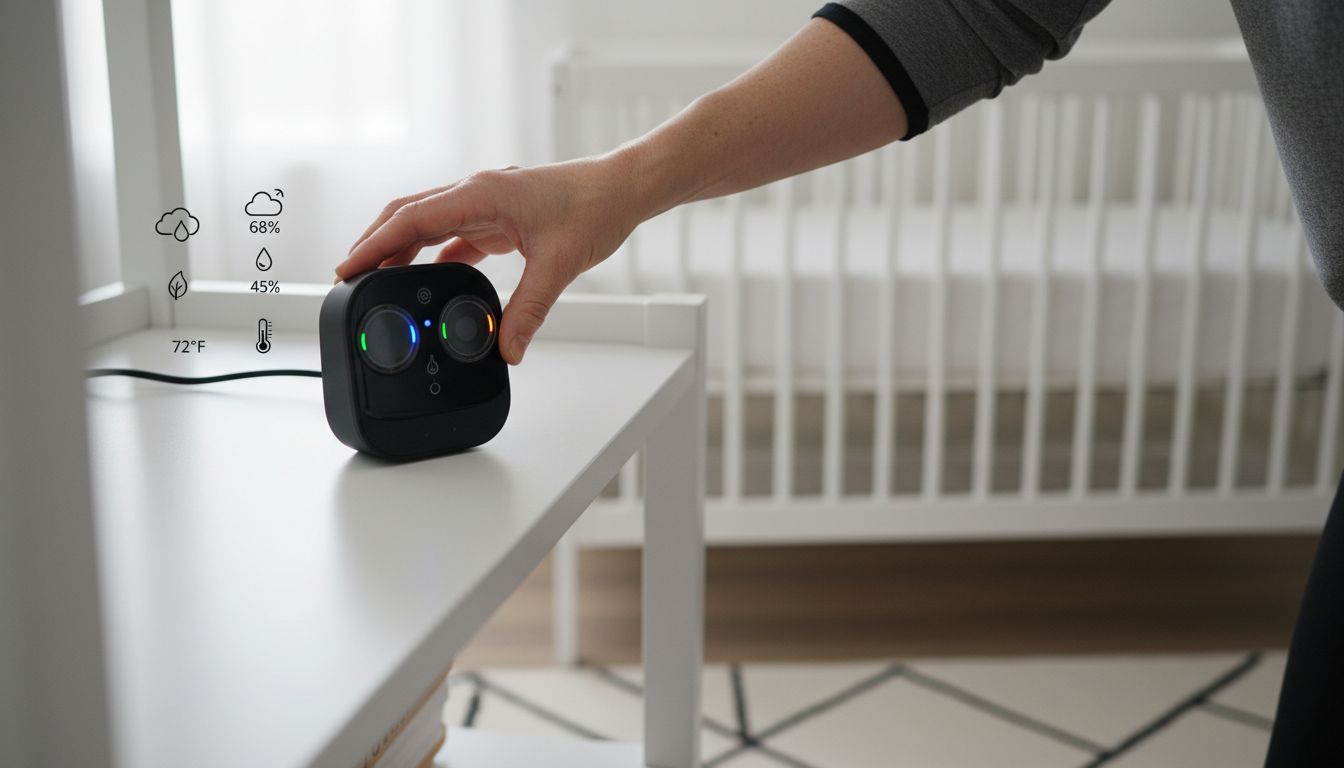 The key is continuous awareness, regular assessment, and swift action when potential hazards are detected.
The key is continuous awareness, regular assessment, and swift action when potential hazards are detected.
Key Features Of Modern Baby Monitors
Today's baby monitors have evolved far beyond simple audio devices, transforming into sophisticated technological guardians that provide comprehensive insights into an infant's environment. Modern monitoring systems blend advanced sensors, wireless connectivity, and intelligent software to give parents unprecedented visibility and peace of mind. These devices are no longer just about hearing your baby cry but about creating a holistic safety ecosystem around your child.
Research highlights several critical features that define contemporary baby monitoring technology:
- Real-time video streaming with high-definition clarity
- Environmental sensors tracking temperature, humidity, and air quality
- Movement detection monitoring infant breathing and physical activity
- Sound and moisture analysis identifying potential distress or discomfort
- Remote mobile device access enabling monitoring from anywhere
- Encrypted communication channels ensuring data privacy and security
The integration of Internet of Things (IoT) technology has revolutionized how parents interact with baby monitoring systems. These smart devices now offer predictive monitoring capabilities, using advanced algorithms to detect subtle changes in an infant's environment that might indicate potential health or safety concerns. For example, sudden temperature fluctuations or unusual sound patterns can trigger immediate smartphone notifications, allowing parents to respond proactively.
Beyond technological features, modern baby monitors represent a comprehensive approach to infant care. They transform raw data into actionable insights, helping parents understand their baby's sleep patterns, breathing rhythms, and overall environmental comfort. By providing a seamless blend of technological sophistication and intuitive design, these monitors are becoming essential tools in modern parenting, bridging the gap between constant supervision and intelligent, unobtrusive monitoring.
Privacy And Security In Baby Monitoring
In the era of connected technology, privacy and security have become paramount concerns for parents using baby monitoring systems. The intimate nature of capturing a child's most vulnerable moments demands rigorous protection against potential digital intrusions and data vulnerabilities. Modern parents must navigate a complex landscape of technological safeguards to ensure their family's most precious information remains confidential and secure.
Key privacy and security considerations for baby monitoring systems include:
- End-to-end encryption protecting all transmitted data
- Secure authentication mechanisms preventing unauthorized access
- Local storage options minimizing cloud-based data exposure
- Regular firmware updates addressing potential security vulnerabilities
- Two-factor authentication adding an extra layer of device protection
- Anonymized data handling preventing personal information tracking
Research from leading organizations emphasizes the critical importance of implementing comprehensive security protocols. Potential risks range from simple unauthorized viewing to more sophisticated data breaches that could compromise a child's digital privacy. Parents must carefully evaluate monitoring systems, looking beyond surface-level features to understand the underlying security architecture. This means examining encryption standards, understanding data transmission protocols, and verifying the manufacturer's commitment to ongoing security updates.
Ultimately, protecting a child's digital footprint requires a proactive and informed approach. Parents should treat baby monitoring technology as a security-sensitive tool, regularly reviewing device settings, changing default passwords, and staying informed about potential vulnerabilities. By maintaining a vigilant and educated stance, families can leverage the benefits of modern monitoring technology while ensuring their child's safety and privacy remain paramount.
Common Mistakes And Best Practices
Parents navigating the complex world of baby room monitoring often encounter common pitfalls that can compromise their infant's safety and comfort. The journey of creating an optimal monitoring environment is fraught with well-intentioned but misguided approaches that can inadvertently introduce risks or inefficiencies. Understanding these potential mistakes is crucial for developing a robust, effective monitoring strategy that truly supports infant well-being.
Common mistakes in baby room monitoring include:
- Over-reliance on technology: Treating monitors as complete substitutes for physical supervision
- Ignoring environmental factors: Neglecting air quality, temperature, and noise levels
- Inconsistent device maintenance: Failing to update firmware or replace aging equipment
- Poor placement of monitoring devices: Positioning sensors incorrectly or creating potential hazards
- Inadequate security configurations: Using default passwords or neglecting network protection
- Misinterpreting monitoring data: Overreacting to minor fluctuations or misunderstanding sensor readings
Best practices emerge from a holistic approach that combines technological intelligence with parental intuition. This means developing a comprehensive monitoring strategy that goes beyond simply watching a screen. Successful monitoring involves creating a layered approach that integrates device technology with regular physical checks, understanding the limitations of technological systems, and maintaining a flexible, adaptive monitoring environment that can evolve with your child's changing needs.
Ultimately, effective baby room monitoring is about striking a delicate balance between technological support and hands-on parental care. It requires continuous learning, regular equipment assessment, and a nuanced understanding that no monitoring system can completely replace attentive, responsive parenting. By approaching monitoring as a dynamic, evolving process rather than a static solution, parents can create a safer, more responsive environment that supports their infant's growth and development.

Take Control of Your Baby’s Room Environment Today
The challenges of monitoring your baby’s room environment go beyond just seeing or hearing your child. As the guide highlights, keeping track of temperature stability, air quality, noise levels, and privacy can feel overwhelming. You want real-time, reliable data to protect your baby from hazards like allergens, pollutants, and unsafe conditions. At the same time, you need peace of mind that your baby’s monitor respects privacy and security without compromising on advanced features.
That is where expert guidance makes a difference. Discover trusted advice and in-depth reviews focused on secure, high-performance baby monitors designed to match your unique home environment at Baby Monitors For Parents. Learn about devices like the Miku Pro 2 and Nanit Pro that combine environmental sensors with encrypted connectivity for safe, all-around infant care. Ready to upgrade your nursery with confidence and safeguard your child’s well-being? Visit https://babymonitorsforparents.pro now and find the perfect baby monitor tailored to your needs.
Frequently Asked Questions
What factors should I monitor in my baby's room environment?
Monitoring your baby's room environment involves tracking several critical parameters, including temperature stability, humidity levels, air quality indicators, sound levels, and light conditions. These factors significantly impact your baby's comfort, health, and safety.
How can monitoring my baby's environment improve their health?
By systematically monitoring environmental factors like air quality and temperature, parents can prevent issues such as respiratory complications and skin irritations. It empowers caregivers to make informed decisions that can enhance their child's overall wellness and sleep quality.
What are common environmental hazards I should be aware of in my baby's room?
Common environmental hazards include lead contamination, indoor air pollutants, pesticide exposure, environmental tobacco smoke, and allergens like dust mites and pet dander. Regularly assessing these factors is crucial for maintaining a safe environment for your infant.
What are key features to look for in a modern baby monitor?
Key features of modern baby monitors include real-time video streaming, environmental sensors for temperature and air quality, movement detection, and remote mobile access. Additionally, look for devices that offer secure data transmission and privacy features to protect your child's information.



